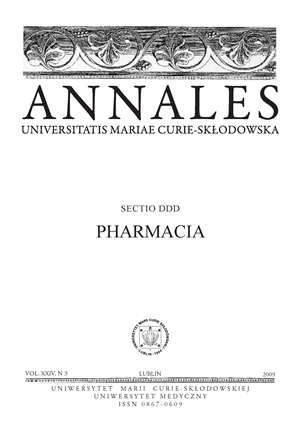Diabetes mellitus alters lysosomal enzymes activity in rabbit epididymis
Abstract
Diabetes is a metabolic disease caused by inappropriate secretion and/or function of insulin, which may disturb morphology and function of various internal organs. The aim of the study was to evaluate the activity of selected lysosomal enzymes. The study was undertaken on male New Zeland white rabbits. Diabetes was induced by intravenous injection of alloxan, and animals were examined on days 21, 42, 90 and 180. The activity of the free and bound fraction of acid phosphatase, betagalactosidase, beta-N-acetyl-glucosaminidase, cathepsin B, D and L, as well as lipase and sulphatase was spectrophotometrically measured in homogenates of the epididymal body. Disturbances of acid phosphatase, B-galactosidase, beta-N-acetyl-glucosaminidase, cathepsin B, D and L were reveled. Lack of significant changes was found for lipase and sulphatase. It could be concluded that diabetes mellitus alerts the activity of selected epididymal lysosomal enzymes.
References
1. Barret t A. J.: Lysosomal enzymes. In: J. T. Dingle (ed) Lysosomes. North-Holland Publishing Co; Amsterdam 1972.
2. Bener A. et al.: Is male fertility associated with type 2 diabetes mellitus?. Int. Urol. Nephrol. 2009 – in press.
3. Burdan F. et al.: The activity and immunoexpression of cathepsin D in rat male reproductive organs. Folia Morphol., 65, 111, 2006.
4. Burdan F. et al.: Hepatic lysosomal enzymes activity and liver morphology after short-time omeprazole administration. Exp. Toxicol. Pathol., 53, 453, 2002.
5. Cornwall G. A. et al.: Gene expression and epididymal function. In: B. Robaire, B. T. Hinton (eds) The epididymis: from molecules to clinical practice. Kluwer Academic/Plenum., 169, New York 2002.
6. Cornwall G. A., Hann S. R.: Specialized gene expression in the epididymis. J. Androl., 16, 379, 1995.
7. Corona G. et al.: Why can patients with erectile dysfunction be considered lucky? The association with testosterone deficiency and metabolic syndrome. Aging Male, 11, 193, 2008.
8. Delfino M. et al.: Prevalence of diabetes mellitus in male partners of infertile couples. Minerva Urol. Nefrol., 59, 131, 2007.
9. Desai K. V., Kondaiah P.: Androgen ablation results in differential regulation of transforming growth factor-beta isoforms in rat male accessory sex organs and epididymis. J. Mol. Endocrinol., 24, 253, 2000.
10. Deshpande A. D. et al.: Epidemiology of diabetes and diabetes-related complications. Phys. Ther., 88, 1254, 2008.
11. Hermo L., Andonian S.: Regulation of sulfated glycoprotein-1 and cathepsin D expression in adult rat epididymis. J. Androl., 24, 408, 2003.
12. La Vignera S. et al.: Andrological characterization of the patient with diabetes mellitus. Minerva Endocrinol., 34, 1, 2009.
13. Luedtke C. C. et al.: Cathepsin A is expressed in a cell- and region-specific manner in the testis and epididymis and is not regulated by testicular or pituitary factors. J. Histochem. Cytochem., 48, 1131, 2000.
14. Maciejewski R. et. al.: Changes of the ATPase, acid phosphatase and alkaline phosphatase reaction intensity in the parotid and submandibular glands of rabbits in experimental diabetes. Folia Histochem. Cytobiol., 37, 99, 1999.
15. Maciejewski R. et al.: Changes in the activities of pancreatic cathepsins D and L and acid phosphatase in the course of alloxan-induced diabetes mellitus in rabbit. Med. Sci. Res., 28, 113, 2000.
16. Maciejewski R. et. al.: Changes in pancreatic lysosomal enzymes activity as the potential factors leading to diabetic enteropathy. J. Physiol. Pharmacol., 52, 823, 2001.
17. Mayorga L. S., Bertini F.: Effect of androgens on the activity of acid hydrolases in rat epididymis. Int. J. Androl., 5, 345, 1982.
18. Saad F., Gooren L.: The role of testosterone in the metabolic syndrome: a review. J. Steroid Biochem. Mol. Biol., 114, 40, 2009.
19. Soudamani S. et al.: Effects of streptozotocin-diabetes and insulin replacement on the epididymis of prepubertal rats: histological and histomorphometric studies. Endocr. Res., 31, 81, 2005.
20. Strawser L. D., Touster O.: The cellular processing of lysosomal enzymes and related proteins. Rev. Physiol. Biochem. Pharmacol., 87, 169, 1980.
21. Wajchenberg B. L. et al.: Glycemia and cardiovascular disease in type 1 diabetes mellitus. Endocr. Pract., 14, 912, 2008.
22. Wójtowicz Z. et. al.: The activity of lysosomal enzymes in visual cortex of rabbits during experimental diabetes. Folia Neuropathol., 33, 159, 1995.
23. Wójtowicz Z. et. al.: Lysosomal enzyme activity of internal and middle layers of renal arterial wall in rabbits. Annales UMCS, Sectio D, 53, 153, 1998.
24. Wójtowicz Z. et. al.: The activity of lysosomal enzymes of rabbits gingiva mucosa during induced experimental diabetes. Annales UMCS, Sectio D, 60, 369, 2005.
25. Wójtowicz Z. et al.: Hepatic lysosomal enzymes activity turning the course of the experimental diabetes in rabbit. Annales UMCS, Sectio D, 60, 908, 2005.
26. Wójtowicz Z. et al.: The activity of lysosomal enzymes of rabbit thyroid gland during induced experimental diabetes. Annales UMCS, Sectio D, 61, 748, 2006.
27. Wójtowicz Z. et al.: The activity of lysosomal enzymes of rabbit skeletal muscles during induced experimental diabetes. Annales UMCS, Sectio D, 60, 369, 2005.
28. Wójtowicz Z. et al.: Activity of testicular lysosomal enzymes in the course of experimental diabetes in rabbits. Annales UMCS, Sectio DDD, 2009, 22 - in press.
Downloads
Published
Issue
Section
License
Copyright (c) 2009 Authors

This work is licensed under a Creative Commons Attribution-NonCommercial-NoDerivatives 3.0 Unported License.


